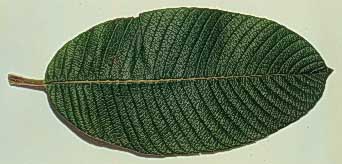
Davilla kunthii A. St.-Hil., Usuel. Bras
Bejuco de Agua
(Dilleniaceae)
 |
Davilla kunthii A. St.-Hil., Usuel. Bras Bejuco de Agua (Dilleniaceae) |
Chavarría, F., Perez, D., Espinoza, R., Masís, A. and Guadamuz, A. 1998. Davilla kunthii Species Page (Dilleniaceae), 20 January 1998. Species Home Pages, Area de Conservación Guanacaste, Costa Rica. http://www.acguanacaste.ac.cr
I. Identificatión:
Woody liana, common in second growth areas.
Flowers:
Davilla kunthii has perfect flowers (both male and female reproductive structures present in the same flower). Petals are yellow-green, calix green, stamens yellow. Inflorescens axillary panicles. Flower buds are dark green. The flower has a sweet smell. Flowering starts in January.
|
Dissected flower |
Detail of the flower showing only two of the 4 sepals |
Fruit:
The fruit is round and petit-pois size (2 sepals form a round strucutre that looks like a fruit) (Janzen & Liesner 1980).
|
Green fruits |
Closed, mature fruits |
|
Inflorescence | |
Leaves:
leaves ares simple and alternate, oval in shape with undualte margin. Upper surface is rough to the touch and the under surface is tomentose. About 5-13 cm in lenght. Upper surface is dark green while the under surfae light green.
The new leaves are brownish-green.
Petiole is cilindrical and about 1-1.5 cm in lenght and pubescent.
|
Under surface |
Upper surface |
|
Detail of the petiole | |
Bark and wood:
The bark is light brown and has scales that come off easily. The wood is white.
|
Bark |
Cross section of the stem |
|
Bark and wood | |
Similar species:
Tetracera y Doliocarpus (Dilleniaceae) are also woody lianas whose leaves might be mistaken with the Davilla kunthii leaves. Tetracera can be recognized by its apocarpic fruits (in this case 4 separete carpels in the flower) (Gentry 1984).
Doliocarpus is a canopy liana in mature humid forests, the leaves are not rough to the touch and have a more or less entire margin. Also the fruit is relatevely large, fleshy, splits open in half and reveals a white suculent with 1-2 seeds (Gentry 1984).
Vegetatively it can also be mistake with Curatella americana,, but this is a shrub that grows in highly altered and open areas.
II.Geographic distribution:
International:
México to Sur América (González 1997).
In Costa Rica:
Pacific watershed, in dry and humid forests (González 1997).
In the Area de Conservación Guanacaste:
Maps of macro-habitats of the ACG
|
III.Natural history:
Drinkable water is obtained by cutting the main stem. It is used as a source of fresh water in the forest (Valverde, 1998).
IV.How to find:
Acknowledgments:
This project was carried out by the Area de Conservación Guanacaste/CR, with help from INBio/CR, ICBG from the Foggarty center, NIH/USA and NSF/USA.
Literature cited:
Gentry, A.H. 1984. A field guide to the families and genera of woody plants of northwest South America (Colombia, Ecuador, Peru), with supplementary notes on herbaceus taxa. Univesity of Chicago Press, Chicago and London.
González. J. 1997. Manual de Flora de Costa Rica. En preparación.
Janzen. D. H. and Liesner. R. 1980. Annotated Check-List of plants of lowland Guanacaste province, Costa Rica, exclusive of grasses and non-vascular cryptograms. Brenesia 18: 1590.
Valverde, O. 1998. Información de historia natural de Davilla kunthii. Museo Nacional de Costa Rica. Com. pers.